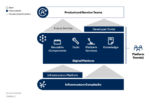
It’s now old news to most people that the rate of change in the lifecycle of a business has accelerated dramatically over the past two decades. Ideas are born, concepts are funded, markets are created, ambitions are expanded, and business models are disrupted and abandoned at a rapid pace. This is equal parts exciting and terrifying, and IT practitioners are constantly seeking new tools to improve their responsiveness to business needs in this new environment.
However, at the same time IT leaders are seeking new tools, most enterprises have sunk significant investments into existing infrastructure solutions that manage the most critical revenue-generating systems they possess. Adapting to new business requirements by deploying new applications and services, without disrupting existing critical business processes, is an insurmountable challenge if dev and ops teams aren’t working together in lockstep.
In order to truly master the DevOps approach— shrinking the gap between request and result by providing updates to services via developing, testing and delivering on a continuous basis— there are three infrastructure steps enterprises should be sure to embrace.
Best of Both Worlds: Roll Out a Hybrid Approach
Public cloud infrastructures may seem to keep things simple but a hybrid environment is ideal for DevOps. Private clouds give enterprises a lot of flexibility for cost-efficient bursting and in an era of data sensitivity, they provide them with an added layer of confidence. Enterprise orgs should pick a cloud vendor that can seamlessly manage both public and private instances together. DevOps teams can experiment and collaborate at breakneck speed, experimenting and learning in public clouds that are quick to deploy and release, while pushing successful updates out securely in private environments.
Make Sure You Are Supporting the Latest and Greatest
If an enterprise’s servers aren’t supporting the latest technologies preferred by DevOps practitioners, they shouldn’t expect their DevOps team to get the best results. It’s imperative for servers to support modern cloud environments that run the latest data infrastructure solutions — such as Hadoop and MongoDB — alongside existing critical enterprise applications. These make it simple for IT practitioners to set up high-performance private clouds that keep critical business data available for use and protected. As your developers begin to tinker with game changing technologies like artificial intelligence and machine learning, choosing platforms that support the latest accelerator technologies, such as GPUs, becomes even more important.
Automate and Collaborate
Agility is the cornerstone of DevOps. To achieve true agility requires that teams work very closely together and automate as many repetitive processes as possible. This frees up IT practitioners for more complex challenges while vastly speeding up overall workcycles. But tools that automate development cycles, like Puppet or Chef do for system setup and configuration, are only as good as the architecture that supports them. Selecting frameworks, development environments and cloud architecture that can be tied together along with the kind of automation and collaboration tools that facilitate fast development and decisions will ensure DevOps paradigms can be maintained the full benefit can be realized.
The rise of DevOps is not a fad. In order for enterprises to truly excel in this new world order they first need to take steps to ensure they are providing their IT practitioners with the right technology portfolio for the job. As pace continues to accelerate, the organizations that make the right technology investments will be the ones that remain most agile, most responsive, most innovative.





